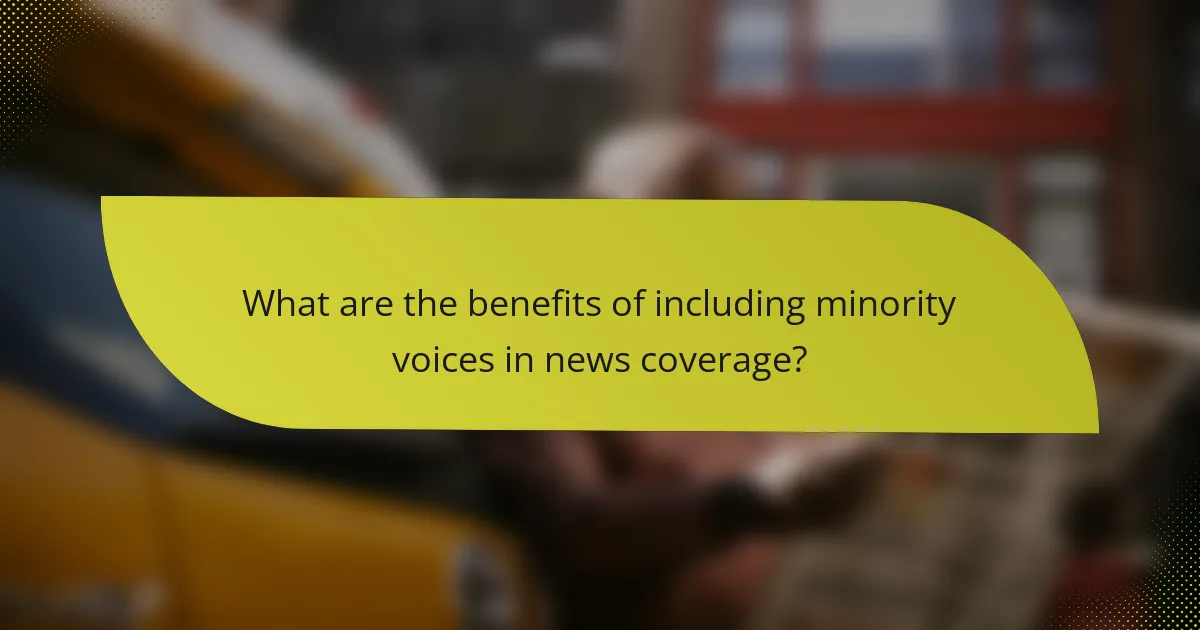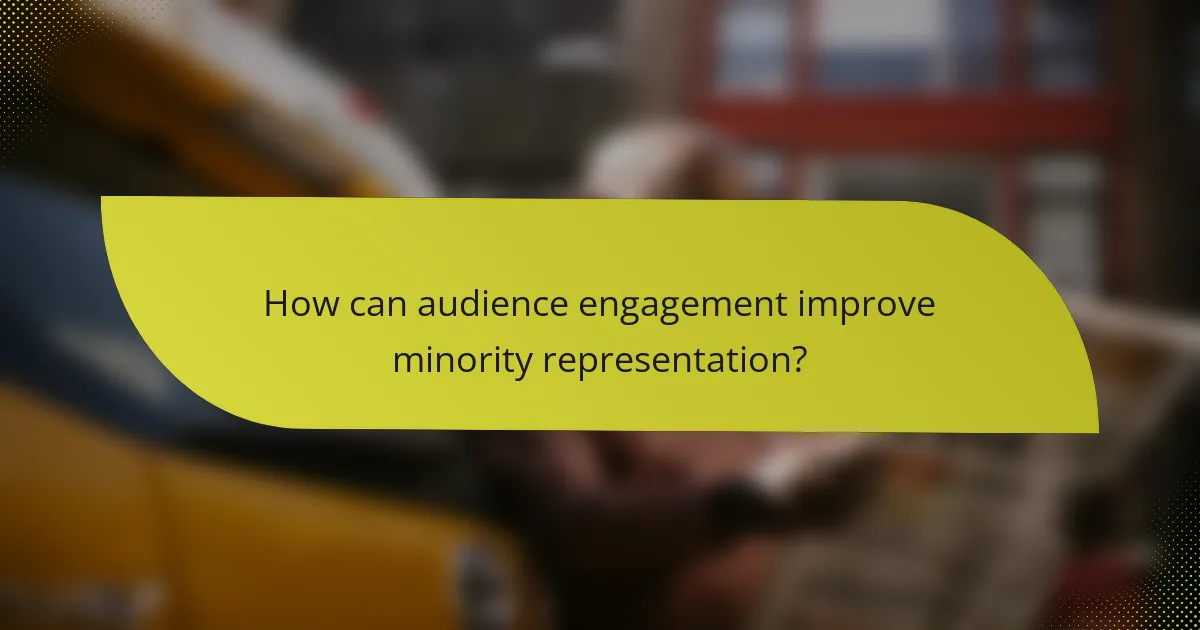Incorporating minority voices in news coverage is essential for fostering a more inclusive media landscape. By prioritizing representation and actively engaging with underrepresented communities, news organizations can enhance the depth and accuracy of their reporting. This practice not only enriches narratives but also builds trust and resonates with a broader audience.

How can news organizations include minority voices effectively?
News organizations can effectively include minority voices by adopting strategies that prioritize representation and engagement. This involves not only diversifying their workforce but also actively seeking input from underrepresented communities.
Implement diverse hiring practices
Diverse hiring practices are essential for news organizations to reflect the communities they serve. This can be achieved by broadening recruitment efforts to include minority-focused job boards, universities, and community organizations.
Additionally, organizations should consider implementing blind recruitment processes to minimize bias. Regular training on diversity and inclusion for hiring managers can further enhance these efforts.
Engage with community organizations
Engaging with community organizations helps news outlets build trust and gain insights into minority perspectives. Collaborating with local advocacy groups can provide valuable context and access to stories that might otherwise go untold.
News organizations should attend community events and forums to foster relationships and understand the issues that matter most to these groups. This engagement can lead to more authentic and relevant coverage.
Utilize social media outreach
Social media is a powerful tool for reaching minority communities and amplifying their voices. News organizations should actively use platforms like Twitter, Facebook, and Instagram to share stories and solicit feedback from diverse audiences.
Creating targeted campaigns that highlight minority issues can encourage engagement and participation. Organizations should also monitor social media conversations to stay attuned to community concerns and interests.
Conduct inclusive editorial meetings
Inclusive editorial meetings are crucial for ensuring that minority voices are represented in news coverage. Organizations should strive to create a culture where all team members feel comfortable sharing their perspectives and ideas.
Incorporating diverse viewpoints into the editorial process can lead to richer, more nuanced reporting. Regularly inviting guest contributors from minority communities to participate in these meetings can further enhance inclusivity.

What are the benefits of including minority voices in news coverage?
Including minority voices in news coverage enhances the depth and accuracy of reporting, ensuring that diverse perspectives are represented. This practice not only enriches the narrative but also fosters a more inclusive media landscape that resonates with a broader audience.
Enhances representation and accuracy
Incorporating minority voices in news stories leads to more accurate portrayals of communities and issues. When diverse perspectives are included, the reporting reflects the complexity of societal dynamics, reducing stereotypes and misconceptions.
For example, a news piece about immigration that features voices from various cultural backgrounds can provide a fuller understanding of the challenges faced by these communities. This approach helps to create a more nuanced narrative that resonates with readers from different backgrounds.
Builds trust with diverse audiences
When news outlets include minority voices, they demonstrate a commitment to inclusivity, which can build trust among diverse audiences. Audiences are more likely to engage with media that reflects their experiences and concerns, fostering loyalty and viewership.
News organizations that actively seek out and amplify minority perspectives can create a sense of belonging for these communities. This trust can translate into higher engagement rates, as individuals feel their stories are valued and represented.
Promotes social justice and equity
Including minority voices in news coverage plays a crucial role in promoting social justice and equity. By highlighting the experiences and challenges faced by marginalized groups, media can raise awareness and drive conversations around important social issues.
For instance, coverage of racial inequality that features firsthand accounts from affected individuals can mobilize public opinion and encourage advocacy for policy changes. This not only informs the public but also empowers communities to seek justice and equity in various spheres of life.

What challenges do news organizations face in this process?
News organizations encounter several challenges when striving to include minority voices in their coverage. These obstacles can hinder the effectiveness and authenticity of their reporting, ultimately affecting public perception and trust.
Resistance to change within the organization
Many news organizations face internal resistance when attempting to diversify their coverage. This resistance often stems from established norms and practices that prioritize traditional narratives over inclusive storytelling.
To overcome this, organizations should foster a culture that values diverse perspectives. Training sessions and workshops can help staff understand the importance of representation and how it enriches news content.
Limited resources for outreach
Outreach to minority communities often requires additional resources, which many news organizations may lack. This includes funding for community engagement initiatives and personnel dedicated to building relationships with underrepresented groups.
Organizations can address this by seeking partnerships with local community organizations or leveraging social media platforms to connect with diverse audiences. Allocating a small portion of the budget specifically for outreach can also yield significant benefits.
Potential backlash from audiences
Including minority voices can sometimes lead to backlash from certain audience segments who may resist changes in narrative or representation. This backlash can manifest as negative feedback or decreased viewership.
To mitigate this risk, news organizations should communicate their commitment to diversity clearly and transparently. Engaging with audiences through forums or social media can help address concerns and foster understanding of the value of inclusive coverage.

How can audience engagement improve minority representation?
Audience engagement can significantly enhance minority representation in news coverage by fostering a more inclusive dialogue. When media outlets actively seek input from diverse communities, they can better reflect a wide range of perspectives and experiences.
Encourages feedback and dialogue
Engaging with audiences allows news organizations to gather valuable feedback from minority groups. This interaction can take place through social media platforms, community forums, or surveys, enabling journalists to understand the specific issues and narratives that matter to these communities.
For instance, a news outlet might host a discussion panel that includes minority voices, allowing them to share their stories and concerns directly. This not only enriches the content but also builds trust between the media and underrepresented audiences.
Increases visibility of underrepresented stories
When audiences are engaged, they can highlight stories that may otherwise go unnoticed. This visibility is crucial for ensuring that the experiences of minority groups are included in mainstream narratives.
For example, a local news station could run a series focused on immigrant experiences in the community, driven by suggestions from audience members. By prioritizing these stories, news outlets can create a more balanced representation of society.

What frameworks support diversity in journalism?
Diversity in journalism is supported by various frameworks that aim to promote inclusive practices and representation in news coverage. These frameworks provide guidelines and initiatives that help journalists and media organizations prioritize minority voices and perspectives.
National Association of Black Journalists guidelines
The National Association of Black Journalists (NABJ) has established guidelines that emphasize the importance of including African American voices in media. These guidelines encourage newsrooms to actively recruit and retain Black journalists, ensuring that their stories and experiences are represented in coverage.
Additionally, NABJ promotes training programs that focus on cultural competency and ethical reporting. By adhering to these guidelines, journalists can better understand the communities they serve and produce more accurate and relatable content.
Society of Professional Journalists diversity initiatives
The Society of Professional Journalists (SPJ) has launched several diversity initiatives aimed at fostering a more inclusive media landscape. These initiatives include scholarships for minority students pursuing journalism and mentorship programs that connect experienced journalists with newcomers from diverse backgrounds.
SPJ also advocates for diversity in editorial decision-making processes, encouraging news organizations to create diverse teams that reflect the demographics of their audience. This approach not only enriches reporting but also builds trust within communities that have historically been underrepresented in media.

What role do technology and social media play in amplifying minority voices?
Technology and social media significantly enhance the visibility of minority voices by providing platforms for expression and connection. These tools enable diverse communities to share their stories, experiences, and perspectives, often bypassing traditional media gatekeepers.
Access to platforms
Social media platforms like Twitter, Facebook, and Instagram allow minority groups to create and disseminate content directly to audiences. This access reduces reliance on mainstream media, which may not always represent their narratives accurately. For instance, grassroots movements can gain traction through viral posts, leading to broader awareness and support.
Community building
Technology fosters community among minority groups by connecting individuals with shared experiences. Online forums, groups, and hashtags create spaces for dialogue, support, and advocacy. These virtual communities can mobilize quickly for social causes, amplifying their collective voice in ways that traditional methods may not achieve.
Influencing mainstream media
As minority voices gain traction on social media, they increasingly influence mainstream media narratives. Journalists and news outlets often monitor trending topics and public sentiment online, leading to more inclusive coverage. For example, movements like #BlackLivesMatter have prompted significant shifts in how issues of race and justice are reported.
Challenges and considerations
While technology amplifies minority voices, it also presents challenges such as misinformation and online harassment. Minority groups may face backlash for their views, which can deter participation. It’s essential for users to engage critically with content and support one another in navigating these challenges to maintain a safe and constructive online environment.
